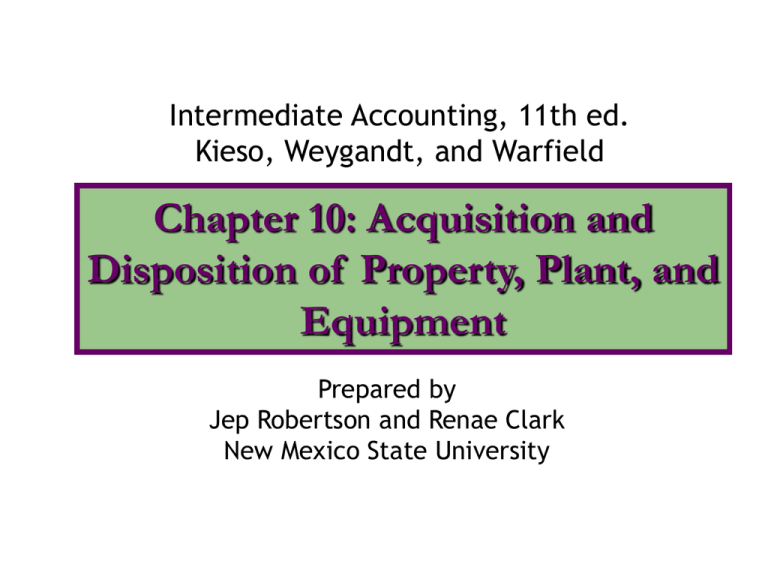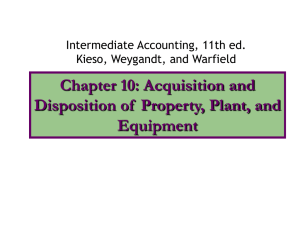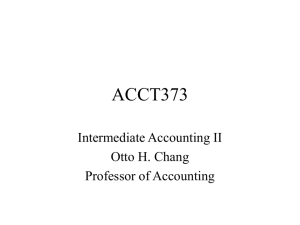
Intermediate Accounting, 11th ed.
Kieso, Weygandt, and Warfield
Chapter 10: Acquisition and
Disposition of Property, Plant, and
Equipment
Prepared by
Jep Robertson and Renae Clark
New Mexico State University
Chapter 10: Acquisition and
Disposition of Property, Plant, and
Equipment
After studying this chapter, you should be able
to:
1.
2.
3.
4.
Describe the major characteristics of property,
plant, and equipment.
Identify the costs included in the initial valuation
of land, buildings, and equipment.
Describe the accounting problems associated with
self-constructed assets.
Describe the accounting problems associated with
interest capitalization.
Chapter 10: Acquisition and
Disposition of Property, Plant, and
Equipment
5. Understand accounting issues related to
acquiring and valuing plant assets.
6. Describe the accounting treatment for
costs subsequent to acquisition.
7. Describe the accounting treatment for
disposal of property, plant, and
equipment.
Property, Plant, and Equipment
(PP&E)
PP&E include:
land, building, structures and equipment
machinery, furniture and tools
They are used in operations and not held for
resale
They are long term and are subject to
depreciation (except land)
They are tangible
Acquisition Cost
PPE is initially valued at historical cost.
Historical cost includes:
• the asset’s cash or cash equivalent
price, and
• the cost of readying the asset for use
Cost of Land
Land costs include:
•
purchase price
•
closing costs, attorney fees, and recording fees
•
costs of getting land ready for use (clearing, etc.)
•
special assessments for local improvements
•
assumption of liens or encumbrances, and
•
additional improvements with an indefinite life
Sale of salvaged materials reduces cost
Land Improvements, Building and
Equipment
Improvements with limited lives are
recorded as Land Improvements (and not as
Land)
Building cost includes:
• costs of materials and labor, and overhead
• professional fees and building permits
Cost of equipment includes:
• purchase price
• freight and handling charges
• costs of special foundation, installation, and initial
testing.
Self-Constructed Assets
•
•
•
•
•
These are assets constructed by the
business for use in operations.
The cost of self-constructed assets includes:
cost of direct materials,
cost of direct labor,
variable manufacturing overhead,
a pro rata portion of the fixed overhead,
and
interest costs incurred during construction
(with modification).
Interest Capitalization: Factors
Three questions must be answered:
1.
Which assets are qualifying assets?
2.
What is the capitalization period?
3.
What is the amount of interest to
be capitalized?
Interest Capitalization: Qualifying
Assets
• They must require a period of time to
make them ready for use.
• There are two types of qualifying
assets:
1. Assets under construction for use in
operations, and
2. Discrete assets intended for sale or
lease.
Interest Capitalization:
Capitalization Period
Capitalization period begins when:
expenditures for the asset have been
made, and
2. activities for readying the asset are in
progress, and
3. interest costs are being incurred
1.
Capitalization period ends when:
1.
The asset is substantially complete and
ready for its intended use.
Interest Capitalization: Amount to
be Capitalized
Capitalize the lesser of:
1. actual interest costs
2. avoidable interest
Avoidable interest is the amount
that could have been avoided if
expenditures for the asset had not
been made
Computing Avoidable Interest:
Steps
1
2
Determine
weighted-average
accumulated
expenditures
Multiply
by
Appropriate
interest rate(s)
Avoidable interest
Capitalize, lesser of
avoidable and
actual interest
Determining Weighted-Average
Accumulated Expenditures
(WAAE): Example
Amber makes the following two payments in 2004:
Jan 31: $24,000
July 31: $18,000
Capitalization period ran from Jan 31 – Dec 31.
What is the WAAE?
Jan 31:
July 31:
$24,000 * (11/12)
$18,000 * (5/12)
$22,000
$ 7,500
WAAE $29,500
Determining the Appropriate
Interest Rate: Example
1.
2.
Amber (in the previous example) had the
following debt outstanding throughout 2004:
10%, 2-year note specifically for the
project: $25,000
8%, 5-year note (other debt): $20,000
What is the appropriate interest rate(s) and
the avoidable interest?
The Appropriate Interest Rate and
Avoidable Interest: Example
2
1
Weightedaverage
accumulated
expenditures:
$29,500
Up to
specific loan,
$25,000 at
10%
$2,500
avoidable
+
3
Excess WAAE
($29,500 less
$25,000 = $4,500)
at
8%
$360
avoidable
$2,860
Comparing Actual and Avoidable
Interest: Example
Avoidable interest:
Actual interest:
•
$25,000 @ 10%
•
$20,000 @ 8%
$2,860
= $2,500
= $1,600
$4,100
• Capitalize avoidable interest of $2,860 (the
lesser of avoidable and actual interest).
• Expense $1,240 ($4,100 less $2,860).
Valuation Issues
• A cash discount, whether taken or not, reduces
purchase price of asset.
• Assets, purchased through long term credit,
are recorded at the present value of the
consideration exchanged.
• Cost of assets, acquired in a basket purchase,
is allocated to assets on the basis of their
relative fair market values.
• If assets are acquired in exchange for stock
then the market valuation of the stock is the
basis for valuation.
Exchange of Non-Monetary
Assets
The basic rule is that the exchange must be
based on:
1. the fair value of the asset given up, or
2. the fair value of the asset received
whichever is clearly more evident.
The rules for gain/loss recognition depend
upon whether the non-monetary exchange
has commercial substance.
Exchange
of
Non-Monetary
Exchange of Non-Monetary
Assets
Assets
• If the future cash flows change as a result of
the non-monetary exchange, then the
transaction has commercial substance.
– Determine whether the risk, timing, and amount
of cash flows arising for the asset received is
different from the cash flows associated with
the outbound asset, or
– Evaluate whether cash flows are affected with
the exchange versus without the exchange
Accounting for Exchanges
Types of
Exchange
Accounting
for Asset
Received
Accounting for
gain/loss
Has commercial
substance
Recognize at
fair value
Recognize
gain or loss
Lacks commercial Book value of
substance
asset(s) given up
No gain or loss
recognized
Dispositions of PP&E
Plant assets may be:
• retired voluntarily, or
• disposed of by sale, exchange, involuntary
conversion
Depreciation is recorded up to the date of
disposal before determining gain or loss.
Gains or losses from involuntary conversion
are often reported as extraordinary items.
Costs Subsequent to Acquisition
•
•
•
•
If cost incurred increase future benefits,
capitalize costs.
If costs maintain a given level of services,
expense costs.
Costs incurred after acquisition can be
classified as:
additions
improvements and replacements
rearrangements and reinstallation
repairs
Improvements and Replacements
Capitalize costs, if
They increase future service potential
Improvements
Substitution of
a better asset
for present
asset
or
Replacements
Substitution of
a similar asset
for present
asset
Capitalization Approaches
• Carrying value of
asset is known
• Substitution approach
• Carrying value of the
asset is unknown
• Capitalize the new
asset (without
removing the old
asset from the pool),
or
• Debit accumulated
depreciation (when
expenditures extend
useful life of asset)
COPYRIGHT
Copyright © 2004 John Wiley & Sons, Inc. All rights reserved.
Reproduction or translation of this work beyond that permitted
in Section 117 of the 1976 United States Copyright Act without
the express written permission of the copyright owner is
unlawful. Request for further information should be addressed
to the Permissions Department, John Wiley & Sons, Inc. The
purchaser may make back-up copies for his/her own use only
and not for distribution or resale. The Publisher assumes no
responsibility for errors, omissions, or damages, caused by the
use of these programs or from the use of the information
contained herein.




